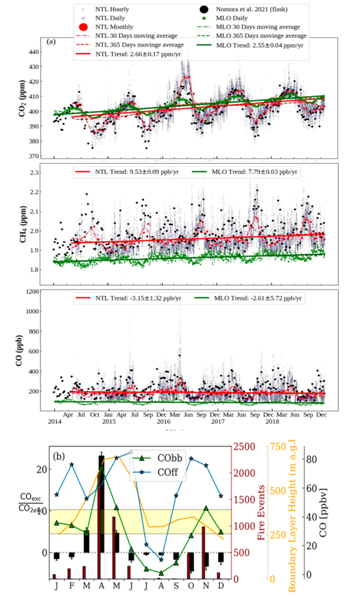Ministry of Science & Technology
Complex greenhouse gas dynamics in the Central Himalayas revealed
Posted On:
17 JUL 2025 5:15PM by PIB Delhi
Indian scientists have, for the first time, captured high-resolution, continuous online measurements of key greenhouse gases in the Central Himalayas highlighting how both environmental factors and human activities jointly impact greenhouse gas levels in this sensitive ecosystem.
Ground observations with diurnal variability over the Himalayas are crucial to validate climate mitigation efforts, build accurate emissions inventories and better forecasting.
In a study performed by the Aryabhatta Research Institute of Observational Sciences (ARIES), an autonomous research institute under the Department of Science & Technology (DST), Government of India, Scientists from the Institute collected data over five years at a high-altitude research site in Nainital.
Dr. Priyanka Srivastava and Dr. Manish Naja found how natural processes and human activities together shape greenhouse gases – carbon dioxide (CO₂) and methane (CH₄) and carbon monoxide (CO) in the Central Himalayan region. The observations fill a critical gap in ground-based atmospheric data for South Asia’s mountain regions, which have long been underrepresented in global climate monitoring.
The unique vantage point of this Himalayan site in Nainital allows researchers to disentangle the effects of biospheric uptake, regional emissions and complex meteorological patterns that shape the region’s air quality and climate.
The research reveals that greenhouse gas concentrations in the Central Himalayas are generally higher than those at other remote background sites, highlighting the influence of emissions from both local and upwind sources. However, these levels remain lower than those typically found in urban and semi-urban settings. The data shows pronounced daily and seasonal cycles, with carbon dioxide reaching its lowest levels during daylight hours due to active photosynthesis, while methane and carbon monoxide tend to peak during the day as mountain winds transport pollutants upward from lower elevations.
Seasonal patterns are also evident: carbon dioxide concentrations rise in spring, coinciding with increased biomass burning and limited vegetation cover, while methane levels are highest in autumn, likely linked to agricultural activities such as rice cultivation. Carbon monoxide peaks in late spring, suggesting a strong influence from regional pollution transport during this period.

Fig. (a) Trend in CO2, CH4, and CO at Nainital (NTL) and Mauna Loa, a background site, during 2014–2018. (b) Monthly variation in excess CO/CO2, ppb/ppm with CO from fossil fuel combustion (COff) and from biomass burning (CObb), fire events over the Northern Indian region (24-35° N, 70-89° E) and boundary layer height at the site location. The yellow highlighted region denotes the emission ratios reported for fossil fuel emissions and biomass emissions.
Long-term trends point to a steady rise in both carbon dioxide (2.66 ppm per year) and methane (9.53 ppb per year). These trends are even higher than those at Mauna Loa (a background site), underscoring the growing impact of anthropogenic emissions in the region. In contrast, carbon monoxide shows a gradual decline (3.15 ppb per year), possibly reflecting improvements in combustion efficiency or changes in regional emission sources.
The study found that factors like solar radiation, temperature and the atmospheric boundary layer—essentially the cap on how high pollutants can rise—are just as important as agricultural practices or urban emissions in shaping these gas patterns.
These comprehensive, high-resolution observations provide an essential baseline for validating satellite data, refining emissions inventories and improving atmospheric models.
By disentangling these influences, the research gives policymakers and climate modelers a powerful tool-- localized, high-resolution data that tells the real-time story of South Asia’s changing climate and offer valuable guidance for climate mitigation strategies and policy development in South Asia.
*****
NKR/PSM
(Release ID: 2145544)
Visitor Counter : 2